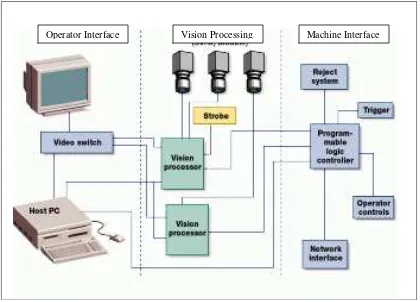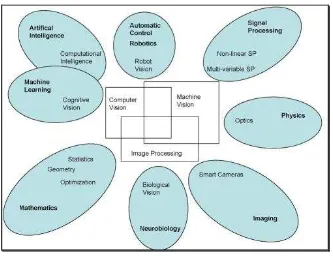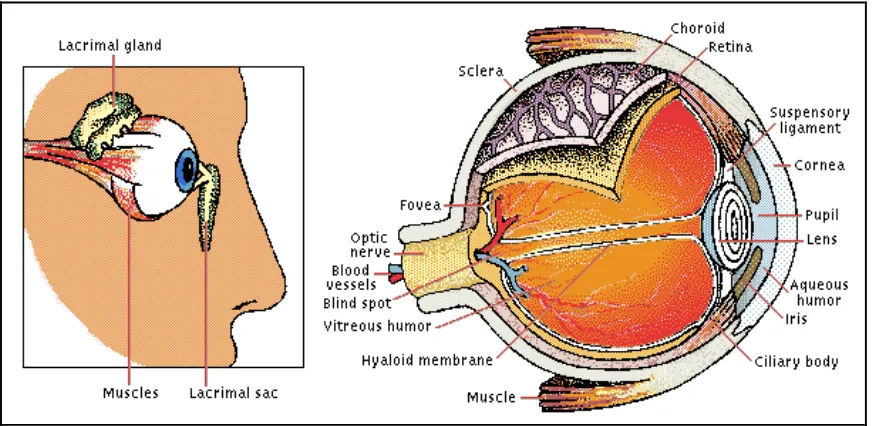UNIVERSITI TEKNIKAL MALAYSIA MELAKA
VISION INSPECTION SYSTEM FOR
PRODUCT DEFECT
Thesis submitted in a accordance with the requirements of the
Universiti Teknikal Malaysia Melaka for the Degree of
Bachelor of Manufacturing Engineering (Robotics & Automation) with Honours
By
SYAHRIL ANUAR BIN IDRIS
B050410219
Faculty of Manufacturing Engineering
APPROVAL
This thesis submitted to the senate of UTeM and has been accepted as partial fulfillment of the requirements for the degree of Bachelor of Manufacturing Engineering (Robotic
and Automation) with Honours. The members of the supervisory committee are as follow:
DECLARATION
I hereby, declare this thesis entitled “Vision Inspection System for Product Defect” is the results of my own research except as cited in the reference.
Signature : ……….
Author’s Name : ………
ABSTRACT
ABSTRAK
ACKNOWLEDGEMENTS
Alhamdullillah, I’m grateful that by the power of Allah, Most Gracious, Most Merciful, I able to complete this project. My thank goes to my parents, who taught me the value of hard work by their own example, who support me both on financial and inspiration. They are my source of inspiration that lead me to working hard in gaining knowledge. Never to forget, to thanks all of my brothers and sisters, because without them I would not be able to finish my project.
I also would like to thank a few people who have made this project a success, for without them, it would be possible to achieve what I have right now. Firstly, I would like to thank my supervisor, Muhammad Hafidz Fazli Bin Md. Fauadi who never ever endlessly to support me, gives opinion, share information and even sacrifice his time just to help me finish this project. . I wish to express my honest thanks to him for the support during the whole project. The encouragement and enthusiasm that was given to me to carry out my project work greatly appreciated. Not to forget other lecturers of BMFA that helps me in gaining the information which helps me in completing the project. The effort shows by the lecturers really touch my heart.
Finally, I would like to thank all who’s directly and indirectly helped me completing my
thesis in time.
TABLE OF CONTENTS
List of Abbreviations, Symbols, Specialized Nomenclature xii
1. INTRODUCTION
2.1.1. Human Vision vs Machine Vision 8
2.1.2. Machine Vision Fundamentals 11
2.1.3. Machine Vision Components 15
2.1.3.1.Camera 16
2.1.3.2.Lighting System 17
2.1.3.3.Part Sensor 20
2.1.3.4.Frame Grabber 21
2.1.3.5.Camera Controller/ PC Platform 21
2.1.3.6.Inspection Software 22
2.1.3.7.Interfaced Circuits 22
2.1.4. Pixels 22
2.1.6. Brightness Adaptation and Discrimination (Contrast) 25
2.2.Machine Vision System 26
2.2.1. Machine Vision Application 28
2.3.Vision Inspection System 29
2.3.1. Design of Vision Inspection System 29
2.3.1.1.Determine Inspection Goals 30
2.3.1.2.Estimation of the Inspection Time 31
2.3.1.3.Identification of Features or Defects 32 2.3.2. Optimizing The Performance of Vision System 33 2.3.2.1.Selection of Lighting and Material Handling Technique 33
2.3.2.2.Selection of Optics 34
2.3.2.3.Selection of Image Acquisition Hardware 35
2.3.2.4.Development of Strategy 36
2.3.2.5.Calibration and Testing Inspection Strategy 36 2.3.2.6.Development of Operator Interface (GUI or HMI) 37 2.4.Inspection & Quality Control/ Quality Assurance 37
2.4.1. Type of Inspection 39
2.5.Pharmaceutical Industry 40
2.5.1. Vision System in Pharmaceutical Industry 41
3.2.2.1.Internet 48
3.2.2.2.Books, Manuals & Magazines 49
3.2.2.3.Journals & Articles 49
3.2.3. Selection & Analysis Tools 49
3.2.3.1.Product Selection 49
3.2.3.2.Programming Software Selection 50
3.2.3.3.Camera Selection 53
3.2.4. Categorized Product Defect 54
3.2.5. Design & Development Inspection System 54
3.3.Project Tools & Equipment 55
5.1.1. Improve Inspection Platform 70
5.1.2. Image Enhancing 71
5.1.3. Image Processing 74
5.1.4. Image Interpretation 78
5.2.Final Outcome Evaluations 82
6. CONCLUSIONS
6.1.Discussions 83
6.1.1. Environment Control 83
6.1.2. Value of Final Result 85
6.1.3. Performance of Camera 86
6.2.Conclusions 88
6.3.Future Work 89
REFERENCES
APPENDICES
A. Checklist form to design Vision Inspection System
B. Mechanical drawings of Product (Medical Container – STREPSILS Cough Syrup)
LIST OF FIGURES
1.1 Vision Inspection System Design 2
2.1 Vision System Field 7
2.2 Structure of Human Eye 8
2.3 Operation of Machine Vision 11
2.4 Edge Detection Route 14
2.5 Basic Machine Vision Components 16
2.6 Variances of lighting components 17
2.7 Front Lighting 18
2.8 Back Lighting 19
2.9 Structured Lighting 20
2.10 Frame Grabber attach to PC 21
2.11 Ways of Reconstructing an Image 23
2.12 The Contrast of Black and White from Imaging Pixels 25
2.13 Machine Vision System Use for Manufacturing 26
2.14 Field of View for Videotape Inspection 34
2.15 Inspection of Product 38
2.16 Inspection of Medical Container 40
2.17 Vision Inspection System Use in Production Line of Medical Container 42
3.1 Flow Chart for Design &Development of vision Inspection System 45
3.2 Personal Computer/ Camera Controller 55
3.3 Web Cam 56
4.1 Inspection Platforms 59
4.16 Threshold Matlab Syntax 69
5.1 Platform of Inspection using Solidworks 70
5.2 RGB to Gray Image Processing Syntax 71
5.3 Syntax for Windowing 71
5.4 Windowing According to Defect 72
5.5 Imtool Overview 72
5.11 Result of Edge Detection of Canny Operator for Crack Defect 75
5.12 Sobel Matlab Operator 75
5.13 Result of Edge Detection of Sobel Operator for Cap Defect 76
5.15 Sample Image 77
5.16 No Size Defect Image 77
5.17 No Size Defect But With Cap Defect 77
5.18 Images with Size Defect 78
5.19 Syntax for Counting White Pixel of Sample Image 79 5.20 Syntax for Counting White Pixels for Real Time Image 80 5.21 Syntax for Compare Sample Image with Real Time Image 80
5.22 Result of Evaluation 81
5.23 Syntax for Display Defect Types 81
6.1 Effect of Glare Due To Glass Reflection 84
6.2 Image Enhancing To Remove Glare 84
6.3 Image for Size Defect 86
LIST OF TABLE
2.1 Evaluation of capabilities 10
2.2 Evaluation of Camera 14
3.1 Selection of Image Processing Software 48
LIST OF ABBREVIATIONS, SYMBOLS, SPECIALIZED
CMOS - Complementary Metal Oxide Semiconductor
CRT - Cathode Ray Tube
DOF - Depth of Field
DPI - Dots per Inch
FDA - Food and Drug Administration
FOV - Field of View
GMPs - Good Manufacturing Practices GUI - Graphic User Interface
PCI - Peripheral Component Interconnect
PPI - Pixel per Inch
RGB - Red Green Blue
CHAPTER 1
INTRODUCTION
1.1Backgrounds
The use of vision to enhance the operation of an automated work cell has moved from research laboratory to the factory floor. Vision systems can be programmed to perform narrowly defined tasks such as counting objects on a conveyor, reading serial numbers, and searching for surface defects. Vision systems are being used increasingly with robot automation to perform the following task:
Part identification: Commercially available vision system store data for different parts in active memory and use the data to distinguish between parts as they enter the work cell.
Part location: Vision technology allows the user to locate randomly placed parts on an X-Y grid. The vision system measures the X and Y distances from center of the camera coordinate system to the center of the randomly placed part.
Part orientation: Every part must be gripped in a specified manner by the end of arm tooling. The vision system supplies the orientation information and data that are used to drive the gripper into the correct orientation for part pickup
Part inspection: Vision systems are used to check parts for dimensional accuracy and geometrical integrity.
Manufacturers usually used vision systems for visual inspections. Visual inspection systems are used to check parts for dimensional accuracy and geometrical integrity. These parts are measured by camera and the dimensions are calculated by the image processing program; at the same time, the vision system checks the parts for any missing holes or changes in the part geometry (Asfahl, 1992). Data collect from the vision system will be analyzed and the defect of the product can be categorized. Refer Figure 1.1 for the communication of vision inspection system.
Figure 1.1: Vision Inspection System Design (Hardin, 2000)
An inspection is, most generally, an organized examination or formal evaluation exercise. It involves the measurements, tests, and gauges applied to certain characteristics in regards to an object or activity. The results are usually compared to specified requirements and standards for determining whether the item or activity is in line with these targets.
Machine Interface Vision Processing
1.2Project Overview
This project will be focusing on inspections system using the vision sensor. The product to demonstrate the inspection system is a medical glass bottle container that used to fill the cough syrup. The product was chosen due to the high quality inspection prefer for this kind of product. Using the available programming software to programming the inspections system, this project will result in the suitable program for inspections defect on the medical glass bottle container.
1.3Problem Statement
In manufacturing process, there will always be a defect in the product. Even though this defect is only 1% from the batch, it is still a defect. For instance, when the product that needs to be exported has slightly 1% of defect, the manufacturing company is putting their profits in line where a great loss to the company can happen due to this 1% of defect. Worst, the company has to bear other consequences such as lost of clients and even being sued for negligence. Therefore this defect should not reach the user, as the last end product should be 100% perfect. Where, the defect can be solved using the visual inspection, ultra wave inspection and other type of inspection.
Visual inspection requires high-speed, high-magnification, 24-hour operation, and repeatability of measurements. All of these tasks extend roles traditionally occupied by human beings, whose degree of failure is classically high through distraction, illness and circumstance. Although humans may display finer perception over the short period and greater flexibility in classification and adaptation to new defects and quality assurance policies, but they make error and can not be hoped 100% perfect with their job (Asfahl, 1992).
The eyes inspection can be reliable for short period of time but in making the system automated, non-stop inspections system and high reliability result are needed in the system. It is impossible for the operators to inspect the product for 8 hours or at least 2 hours straight without making any flaws in its inspections.
1.4Objectives
In order to develop a successful project, objectives should be achieved. The objectives are required to assist and guide the development of the project. The objectives for this project are to:
categorize the defect (defect by vision system, defect by product) and store the defect data in a database
1.5Scopes
a) Vision System
The system are use only for inspection of the medical container – STREPSILS cough syrup bottle only
The inspection will detect defect of that bottle only
b) Camera
The camera is choosen based on the application and economical expense. The chosen camera will be use only to acquire picture to be process by the
image processing software.
c) Product
The product selected to be use for the project is only one type, which is empty medical glass container – STREPSILS cough syrup bottle
This vision inspection system will be only focusing defect of the bottle on that type of product only.
d) Programming Image Processing Software
Image processing software selected is use to process the image and compare with the original image.
CHAPTER II
LITERATURE REVIEW
2.1Vision System
Vision can be describe as ability to see the features of objects that look at, such as color, shape, size, details, depth, and contrast. Vision is achieved when the eyes and brain work together to form pictures of the world around. Vision begins with light rays bouncing off the surface of objects. These reflected light rays enter the eye and are transformed into electrical signals. Millions of signals per second leave the eye via the optic nerve and travel to the visual area of the brain. Brain cells then decode the signals into images, providing sight to the human (Microsoft ® Encarta ® 2006).
In industry sector, vision is use with machine to automate the system. It consists of establishments that supply technology used in manufacturing industries as a substitute for the human vision function. It is made up of suppliers of systems that embody techniques leading to decisions based on the equivalent functionality of vision, but without operator intervention.
Machine vision system can be characterized as newly approach field and diverse. The machine system is now being used in many fields such as medical, industrial quality control, military, astronomy field and other fields. Figure 2.1 shows the field of vision system.
Figure 2.1: Vision System Field (Zuech, 2000)
2.1.1. Human Vision vs Machine Vision
Living creature eye can be defined as light-sensitive organ of vision in humans (Microsoft ® Encarta ® 2006). The eyes of various species vary from simple structures that are capable only of differentiating between light and dark to complex organs, such as those of humans and other mammals, which can distinguish minute variations of shape, color, brightness, and distance. The actual process of seeing is performed by the brain rather than by the eye. The function of the eye is to translate the electromagnetic vibrations of light into patterns of nerve impulses that are transmitted to the brain (Microsoft ® Encarta ® 2006).
The eye is nearly sphere, with an average diameter of approximately 20mm. Three membranes enclose the eye: the cornea and sclera outer cover, the choroids, and the retina. The cornea is a tough, transparent tissue that covers the anterior surface of the eye. Continuous with the cornea, the sclera is an opaque membrane that encloses the remainder of the optic globe. Refer Figure 2.2 for the structure of human eye.
The innermost membrane of the eye is the retina, which lines the inside of the wall‟s entire posterior portion. When the eye is properly focused, light from an object outside the eye is imaged on the retina. Pattern vision is afforded by the distribution of discrete light receptors over the surface of the retina. They are two classes of receptors: cones and rods. The cones in each eye number between 6 and 7 million. They are located primarily in the central portion of the retina, called the fovea, and highly sensitive to color.
The fovea itself is a circular indentation in the retina of about 1.5mm in diameter. Fovea can be view as a square sensor array of size 1.5mm x 1.5mm. The density of cones in that area of the retina is approximately 150,000 elements per mm2. Based on these approximately, the number of cones highest acuity in the eye is about 337,000 elements. Just in terms of raw resolving power, a couple-charged-device (CCD) imaging chip of medium resolution can have this value of elements in a receptor array no larger than 5mm x 5mm (Gonzalez, 1992).


